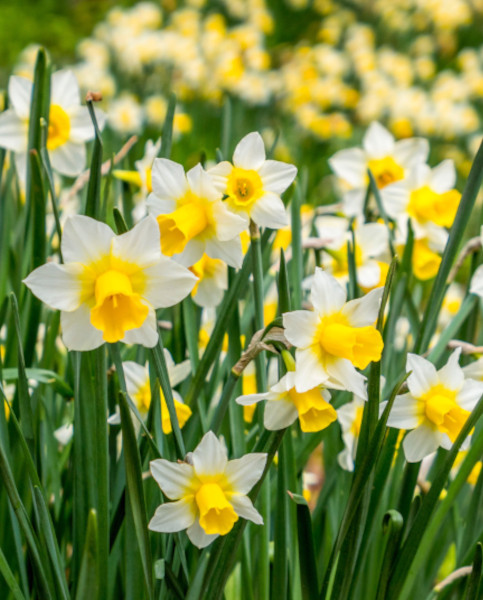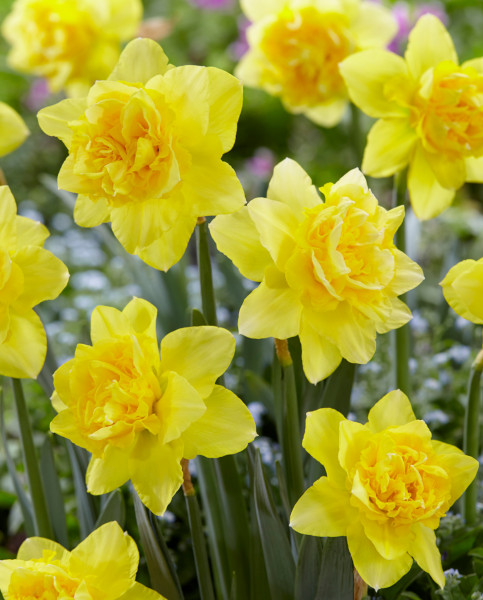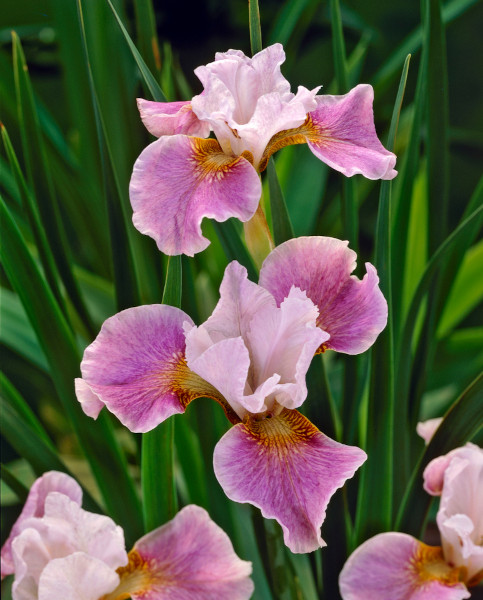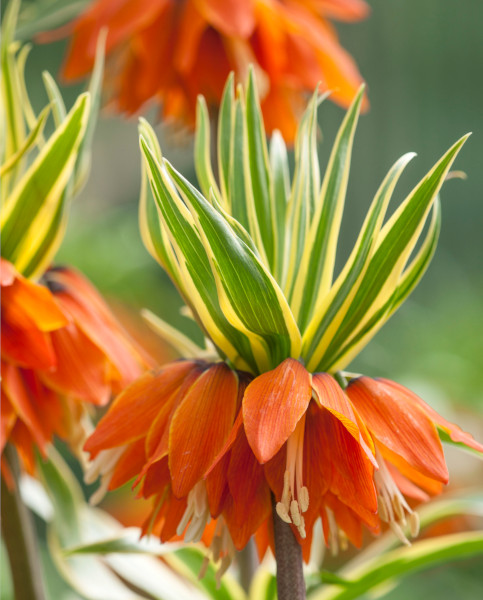How to grow Narcissus
Commonly known as daffodils. Although there may be a little confusion here as Narcissus is the botanical name to which daffodils, narcissus and jonquils belong. From a horticultural perspective, they are similar in form although jonquils have rounded tips to the leaves and daffodils and narcissus have blade-like tips. Jonquils are only yellow, but daffodils and narcissus come in a variety of colours such as white, pink, peach and even zesty limes. For further reference, the 12 groups which belong to the Narcissi family are as follows - Trumpet, Large cupped, Small cupped, Double, Triandrus, Cyclamineus, Jonquilla, Tazetta, Poeticus, Bulbocodium, Split Corona and Other Cultivars (the few that do not fit into the other categories – the well-known Tete-a-Tete is included in this group). However, for the purposes of growing – these can be treated as one and planted, cared for and propagated in much the same way.
There can be no doubt, however, that they are such a welcome symbol of the arrival of Spring and add some gloriously sunny colour in the garden. Wordsworth loved narcissus, Hockney loved them and we, as a nation, love them in equal measure as they wave and nod their pretty heads on the spring breezes to lift our spirits and warm our mood.

Key Information
Soil pH
Position
Hardiness


Where, when and how to plant Narcissus- outdoors:
Outdoors – Best to plant in September to November , as you need to get your bulbs into the ground before it freezes. Narcissus prefer to grow in well-drained, or even sandy, soil so if you garden on heavy clay – add some grit to the hole before planting as they do not like to sit in wet soil over winter and may rot away as a consequence. Mid-late autumn is the ideal time to plant because this is when the bulbs are dormant. The cold of winter followed by the warmth of spring is what stimulates your narcissus to growth each year. Plant each bulb at 2-3 times its own depth (10-15cm is about average) and ensure they are spaced with their own width between them.
Narcissus can be grown in most parts of the garden and look lovely when planted in multiples of 10 or more. They are readily adapted to containers, woodland borders, rockeries, raised beds or to naturalising in grass dependent upon your needs.
If you choose to naturalise your narcissus, then gently cast a handful of bulbs to the ground and plant them into the ground where they land. This will give you a more ‘random’ planting style and achieve that truly naturalised effect.
If you are feeling adventurous you could try lasagne planting with other bulbs for an extended spring display (see our guide on how to undertake this style of planting). Check your chosen variety for its flowering window in order to get the best out of your display.
Where, when and how to plant Narcissus- indoors:
Indoors - another popular way of growing Narcissus is to ‘force’ them into early bloom for decoration in the house. They make a really cheerful display at Christmas time and the scented varieties will fill the room with their delicious bouquet. This works best with the heavily scented varieties of Narcissi such as Paperwhite and Tete-a-tete.
If you buy ‘prepared’ bulbs this means they have already been chilled, if they are not ‘prepared’ then you will need to chill them between 1-10°c for 10 weeks prior to planting - in order to simulate winter conditions. You can then bring them indoors at around 15°c and plant-up in your choice of container using a moist, well drained growing medium. They will then interpret Spring has arrived and begin to shoot, grow and bloom for you.

What to plant with Narcissus
Swathes of Narcissus look marvellous on their own – especially when planted on mass. You may wish to container plant with other Spring flowers and foliage for a focal point in your garden, or extend the container’s season by mixing with other later flowering Spring plants. If you choose to plant bulbs in your borders then they sky is the limit and very dependent upon your personal preferences – a timeless cottage garden, a native woodland garden or a more formal border that has been especially choreographed for colour, tone and texture.
Our personal favourites include Fritillaria Meleagris, Fritillaria acmopetala, Iris reticulata Clairette, Chaenomeles crimson and gold and Erysimum Collection.



How to care for Narcissus
Caring for Narcissus is mostly in the preparation of the soil and ensuring you have created the right conditions up to the point where they bloom in spring. Aftercare is relatively easy and there are some important things to remember. Remove the flower heads once they are spent as you want the bulb to begin restoring nutrients ready to flower again next year. The plant does this by photosynthesis as well as absorbing nutrients from the soil, so it is important to leave the foliage on the plant until the point it has yellowed and died back. This means you will need to leave the areas of grass where you have naturalised bulbs until the foliage is ‘spent’ before mowing – just mow up to the edges and leave the rest for a while. ‘No mow May’ was promoted in 2021 as being great for wildlife too - so you can do your bit for the environment at the same time.
If by some small chance your Narcissus fail to flower (known as daffodil blindness) then it will either be due to overcrowding or some kind of pest or disease. Dig these ones up during their dormant period and check for signs or symptoms. Discard infected bulbs and divide any which are overcrowded, replanting with suitable spaces between each bulb. Avoid replanting bulbs in an area which has had disease as it is likely to remain in the soil.
As Narcissi are hardy there is no real need to lift each year but if you wish to replant elsewhere, or if you have planted them in containers, then lift in July and give 24-48 hours to dry a little before storing in a labelled net (or paper bag) in a cool, dark, dry area. The bulbs can then be replanted in the autumn.
How to propagate Narcissus
Best propagated by division of large clumps in late-summer to early-autumn. Narcissus can also be grown from seed or propagated by chipping but, as they are so cost effective to buy, these latter two methods of propagation are more commonly used by breeders in search of new varieties. The only exception is if you have a variety which will self-seed and you wish for it to naturalise where it is planted – in this case allow the flowers to set seed in June.




